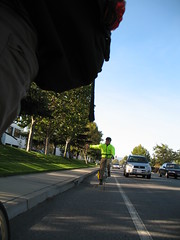Signaling right turns: left or right arm better?

Is one way or the other better for communicating to other cyclists and drivers? The Santa Clara Bicycle Coalition summarizes some interesting research into the matter:
What's the safest way to signal that you're turning right? According to a 1979 study by Drury & Pietraszewski, the bent-left-arm signal was correctly perceived by 65% of following drivers, but the straight-right-arm signal was perceived correctly by 78%. Not only is it safer, but the right arm signal is easier to teach children: "Point which way you're going."
The study also determined that correct perception of arm signals was reinforced by the position of the bicyclist on the road. Finally, if a bicyclist looks back, drivers interpret it to mean that the cyclist is about to do something, but they don't yet know what.
The conclusion is that we should look back at drivers to get their attention, point in the direction of our turn, and move when safe to the correct road position for that turn.
The original research is reported in C. G. Drury, and P. Pietraszewski (1979), "The Motorist's Perception of the Bicyclist's Hand Signals," Ergonomics, 22.9, 1045-1057. The abstract of that research states:
The efficacy of both formal hand signals and informal body signals made by bicyclists was measured on 97 subjects ranging in age from 18 to 75 yrs. Slides of a bicycle rider approaching an intersection were shown to subjects whose task was to respond with the intended action of the rider (Left Turn, Straight Ahead, Right Turn or Stop) and to rate their confidence in their response (high or low). Forty-eight slides were shown comprising eight different signal conditions combined with six positions across the width of the roadway. Subjects were able to derive considerable information from rider position and from informal body signals such as looking over the shoulder. Hand signals were not perfectly recognized with about 20% errors for straight-arm signals and 35% errors for bent-arm signals. The implications for changes in the law and in training schemes are given.
Since 2005, when the Bicycle Safety Bill sponsored by Representative Mike Sutherland and supported by the Missouri Bicycle & Pedestrian Federation was passed by the Missouri General Assembly and signed into law, Missouri law has allowed bicyclists to signal the right turn with either left hand or right hand.
Photo credit:Richard Masoner, http://www.flickr.com/photos/bike/ / CC BY-SA 2.0
- Cycling Tips and Stories
- 2005
- 2010
- 501c3
- about
- active lifestyle
- bicycle
- bicycle safety
- bicycle safety bill
- bicyclist
- bicyclists
- Bike
- bill
- children
- conditions
- cyclist
- drivers
- drury
- engineering
- errors
- form
- general assembly
- illinois
- links
- mike sutherland
- missouri
- missouri bicycle federation
- missouri general assembly
- Missouri Tourism
- motorist
- pedestrian
- photos
- platform
- research
- safety
- santa
- story
- study
- training
- vacation
- Bicycle
- Car safety
- CDATA
- Cycling
- Hand signals
- http://www.flickr.com/photos/bike
- Land transport
- Manual communication
- Mike Sutherland
- Missouri
- Railway signal
- Railway signalling
- Recreation
- Richard Masoner
- Road transport
- Santa Clara
- Sustainable transport
- Transport
Join MoBikeFed's Advocacy Network
Working together we make a real difference! Join our advocacy network:
Current topics...
Archives...
Want better bicycling and walking in Missouri?
We rely on the support of members like you. Please join, renew, or donate today.
- Home
- JOIN/DONATE
- News/Info
- Missouri Bicycling, Running, Trails
- Bicycle Skills and Safety
- Missouri Bike/Ped Law
- Clubs and Organizations
- Bike Shops
- Running Shops
- Bicycling, Running, Trails-related Businesses
- Ride, Run, Walk, Hike, Triathlon, and Events Calendars
- Bicycles on Amtrak
- Maps and Routes
- Trails and Trail Maps
- IBikeMO.org
- Planning a Missouri bicycle trip
- Gravel and Bikepacking Maps & Routes
- Bicycle & Touring Routes
- Advocacy
- Campaigns
- Our Legislative Platform
- Complete Streets
- Statewide Rock Island Trail
- Statewide Trail Vision - Quad State Trail
- Bicycle Friendly Missouri
- Walk Friendly Missouri
- Safe Routes to School
- MoDOT funding crisis
- High Priority Bike/Ped Project List
- Anti-harassment laws in cities & statewide
- Updating the basic bicycle law
- Our Vision for MoDOT
- Our Vision for MPOs/RPCs
- Our Vision for Cities & Counties
- Bicycle, pedestrian, trails plans across MO
- Protecting Vulnerable Road Users
- Vision Zero
- Missouri Trail Towns
- Store
- About

